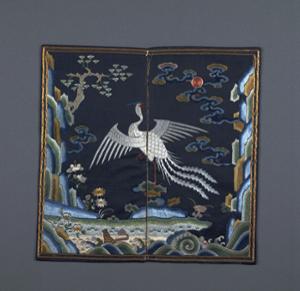Mandarin Square
Buzi or Mandarin squares are embroidered badges of rank, worn on the outer coats of Chinese statesmen, military officials, and their wives from the 15th to 20th century CE. Fierce animals such as leopards, lions, and bears represent military officials, while various bird species including the silver pheasant, mandarin duck, and egret symbolize civic officials. The Buddhist and Taoist symbols scattered among the waves and cloud backgrounds in the squares, highlight the syncretism of religious beliefs in China at the time of their manufacture. Standing in for the Emperor and often depicted as a red disk on the upper part of the square, the sun serves as a focal point for many of the animals to look up to and revere.
The Penn Museum's collection of Mandarin squares was acquired by Brigadier-General J. S. Letcher in Beijing right before the Sino-Japanese war in 1894. It consists of 150 badges, including many unorthodox pieces that were most likely used in wedding or funeral ritual dress.
- Object[1]
- yes[1]
- no[1]
- asian[1]
- china[1]
- qianlong[1]
- qing dynasty[1]
- chinese[1]
- gold thread[1]
- peacock feather[1]
- satin[1]
- silk[1]
- couched[1]
- embroidered[1]
- peking knot[1]
- satin stitch[1]
- stem stitch[1]


